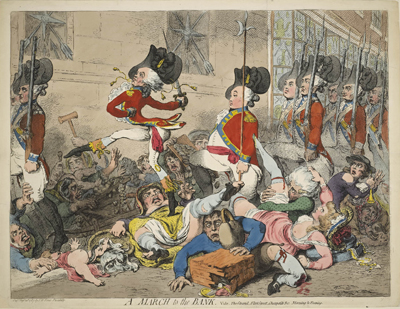A March to the Bank
Since the Gordon Riots of 1780, when anti-Catholic mobs vandalized houses and shops, broke into prisons, and attacked the Bank of England, a nightly guard on the Bank had been established. Every evening soldiers would march from their barracks to the Bank, and every morning they would return by the same route.
As Dorothy George points out, Gillray's March to the Bank (1787) has its origin in complaints about the rudeness and indifference of the solidiers to the ordinary foot traffic of common citizens along the way. An article in the Whitehall Evening Post on July 18th 1787 records one such complaint presented to a Court of Aldermen in Guildhall.
Mr.Walter, in a letter address'd to the Court, complained of the guards who march into the city every evening in order to protect the Bank, forcing him off the pavement, and practicing the same to every person that did not precipitately retire out of their way. The court recommended to the Lord Mayor to write to the Secretary at War to desire he will order them to march in a single row through the city.

© Trustees of the British Museum
But what a contrast between the simple germ of the idea and Gillray's amazing execution! The tension between order and precision versus chaos and extravagance is one of the hallmarks of Gillray's style. And here is one of the finest early expressions of that tension. The soldiers march mechanically and imperturbably on their way to guard the bank, led by their self-absorbed and high-stepping sergeant. But in so doing they create the very chaos, disorder, fear, and violence they were meant to prevent.
The right hand background of the print features the upright marching soldiers with their guns and bayonets held in perfect order, the regular panes of the shop window, and solid stones of an official-looking building. But elsewhere, all is chaos. A newsboy with his trumpet cowers in fear on the right. In the center of the print, the leg of a porter carrying a box of plate and jewels has been grotesquely broken, and the contents of the box exposed. On the far left a woman is unable to prevent a soldier from stepping on the face of her infant. And the proud sergeant treads precisely upon the stomach of a fallen fisherwoman.
Were this a serious depiction of the scene, the horror, cruelty, and violence would provoke genuine outrage against the soldiers and sympathy for the poor vendors trampled upon as they try to pursue their business. And we do feel that the irony of a blind attention to order creating such complete havoc and disorder is central to the print.
But like so many caricature prints, the sense of outrage or compassion is deflected by the extravagance of the caricature itself (especially the caricature of the central soldier), the comedy of sexual exposure in at least two of the women, and the sheer number of incidents which ultimately prevent our focus from falling on any single figure. Gillray makes his point, but we are emotionally insulated from the real basis of his satire and can even enjoy the brilliantly controlled extravagance of the depiction.
Postscript 09/27/2023
According to Draper Hill's commentary on this print, "By 1787, the guard consisted of one officer, two sergeants, two corporals, 29 men, and a drummer-piper." So the prancing soldier is likely the officer (NOT the sergeant as I said) and the stolid figure carrying a halberd is more likely one of the sergeants. Thanks to Rowin Buist for the correction.
Sources and Reading
- Commentary from the British Museum on A March to the Bank
- Draper Hill, The Satirical Etchings of James Gillray #11, 1976
Comments & Corrections
NOTE: Comments and/or corrections are always appreciated. To make that easier, I have included a form below that you can use. I promise never to share any of the info provided without your express permission.